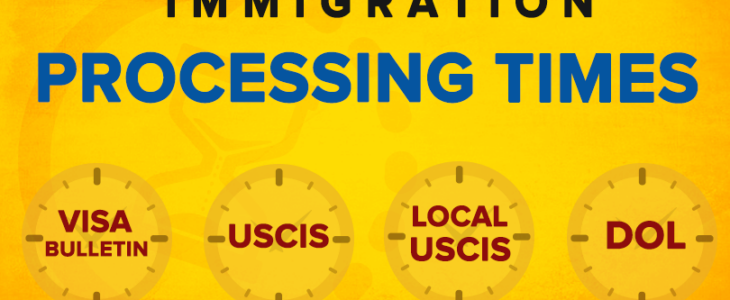Welcome to our September 2023 Newsletter! This month, we are focusing on processing times for the United States Citizenship and Immigration Services (USCIS) and the National Visa Center (NVC). With a number of policy changes and delays due to the current backlogs, keeping up to date is more important than ever.
Processing Times: USCIS and NVC
USCIS
- Application Types: USCIS processing times differ depending on the type of application—be it a visa application, citizenship application, or family sponsorship.
- Time Period: As of the latest reports, processing times vary between 14 to 58 months for many applications, although this can be longer due to the severe back up in USCIS departments.
- Case Status: You can check the status of your case online by using the “Case Status Online” feature on the USCIS website.
NVC
- Application Types: NVC processing typically comes after USCIS and deals with family-sponsored visas and some employment-based visas.
- Time Period: Current processing times at NVC are generally between 6 to 18 months, again this process can be longer due to caseloads backing up due to the COVID-19 pandemic closure.
- Case Status: You can also check the status of your case via the CEAC portal on the Department of State website.
How to Check Processing Times
- USCIS: Navigate to the USCIS website and go to the “Check Case Processing Times” page. Select your form number and the USCIS office where you submitted your case.
- NVC: Log into the CEAC portal and enter your case number to get the most recent updates.
Frequently Asked Questions (FAQ)
1. How can I expedite my USCIS case?
Expedited cases are rare and usually require a demonstrable emergency. This department is also having delays due to case backlogs. Contact us to discuss your specific circumstances.
2. Is premium processing available for all visa types?
No, premium processing is limited to certain employment-based visa categories.
3. Can I visit the U.S. while waiting for my visa application to be processed?
Generally, it’s not advisable as it may appear you are attempting to bypass the immigration process.
4. What are the main reasons for visa denials?
Insufficient documentation, criminal history, and public charge concerns are some of the most common reasons.
5. How can I check my NVC case status?
You can check it through the CEAC portal on the Department of State website.
6. Why do processing times vary between different USCIS centers?
Different centers have different workloads, affecting the processing speed.
7. Can I change my interview location?
Usually, but there are certain protocols and paperwork to follow.
8. How do I know if I need to provide additional documentation?
Both USCIS and NVC will send notices if more documentation is needed.
9. Do I have to pay fees for both USCIS and NVC?
Generally, yes. Fees for USCIS and NVC are usually separate.
Fun Facts About Immigration Processing Times
- No Guarantees : Although the time estimates given here are good, processing times can vary a lot. USCIS makes no guarantees about the exact timing for a given case.
- Government Shutdown Effects: If the U.S. government shuts down, it can significantly impact processing times. During the 2018-2019 government shutdown, for example, thousands of immigration court hearings were canceled.
- Digital Delays: Despite advancements in technology, digital system outages and updates can still slow down processing times, sometimes even more than paper-based backlogs.
- Holiday Seasons: Processing times often slow down around major U.S. holidays like Christmas and Thanksgiving due to office closures and reduced staffing.
- Personal Stories: Some applicants have taken to social media or started campaigns to draw attention to exceptionally long processing times for their cases, which sometimes prompts quicker action.
- Surge Season: USCIS often experiences a “surge” in applications around election years and significant policy announcements, affecting processing times.
- Global Influence: Events around the world, such as crises or changes in international policy, can cause a spike in applications, affecting the processing speed for everyone.
- Legal Battles: Changes to immigration policy often face legal challenges, and the ensuing legal battles can create uncertainties in processing times.
- Public Charge Rule: When new rules are introduced, like the “Public Charge” rule in 2022, it often results in applicants taking longer to prepare their documents to ensure compliance, indirectly affecting processing times.
Processing times are more than just a set of numbers; they are influenced by a myriad of factors, both predictable and unpredictable. We hope you found these facts enlightening!
For any personal queries or assistance with your immigration needs, don’t hesitate to reach out to Zepeda Law Firm. Remember, understanding and navigating immigration law is a journey, and we’re here to guide you every step of the way.
Stay tuned for more insights and updates from the world of immigration law. Until next week!
Sources:
- https:https://egov.uscis.gov/processing-times/
- https://www.boundless.com/immigration-resources/uscis-processing-times/
- https://www.cliniclegal.org/resources/religious-immigration-law/updates-uscis-processing-times
Picture source; https://www.visapro.com/processing-times/


